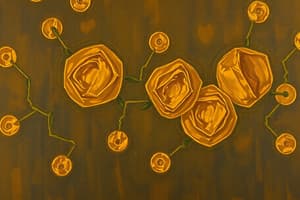Podcast
Questions and Answers
What is the characteristic mode of reaction of alkanes?
What is the characteristic mode of reaction of alkanes?
- Addition reaction
- Substitution reaction (correct)
- Elimination reaction
- Oxidation reaction
What is the product formed when ethene reacts with hydrogen iodide?
What is the product formed when ethene reacts with hydrogen iodide?
- Iodoethane (correct)
- Fluoroethane
- Bromoethane
- Chloroethane
What is the reactivity order of hydrogen halides with alkenes?
What is the reactivity order of hydrogen halides with alkenes?
- HCl > HBr > HI > HF
- HI > HBr > HCl > HF (correct)
- HBr > HI > HCl > HF
- HF > HCl > HBr > HI
What is the product formed when alkenes undergo hydration?
What is the product formed when alkenes undergo hydration?
What is the reagent used for the oxidation of ethane to ethane-1,2 diol?
What is the reagent used for the oxidation of ethane to ethane-1,2 diol?
What is the result of adding water to a compound?
What is the result of adding water to a compound?
What is the catalyst used in the reaction of ethene with hydrogen iodide?
What is the catalyst used in the reaction of ethene with hydrogen iodide?
What is the general formula for Aldehydes and Ketones?
What is the general formula for Aldehydes and Ketones?
Which of the following is an example of a nitrile?
Which of the following is an example of a nitrile?
What is the purpose of ethyne in oxyacetylene flame?
What is the purpose of ethyne in oxyacetylene flame?
Which functional group is characteristic of an amide?
Which functional group is characteristic of an amide?
What is the difference between an aldehyde and a ketone?
What is the difference between an aldehyde and a ketone?
Which of the following is an example of an ether?
Which of the following is an example of an ether?
What is the reactivity order of hydrogen halides with alkynes?
What is the reactivity order of hydrogen halides with alkynes?
What is the IUPAC name for CH3COOH?
What is the IUPAC name for CH3COOH?
What is the general rule for naming aldehydes?
What is the general rule for naming aldehydes?
What is the correct order of steps for naming ketones?
What is the correct order of steps for naming ketones?
Which type of reaction involves the formation of a β hydroxyketone or β hydroxyl aldehyde?
Which type of reaction involves the formation of a β hydroxyketone or β hydroxyl aldehyde?
What is the characteristic of aldehydes and ketones compared to alcohols?
What is the characteristic of aldehydes and ketones compared to alcohols?
What is the name of the polymer used in latex-free laboratory and medical gloves?
What is the name of the polymer used in latex-free laboratory and medical gloves?
What is the general term for organic compounds containing multiple nitrile groups?
What is the general term for organic compounds containing multiple nitrile groups?
What is the purpose of aldol condensation in organic synthesis?
What is the purpose of aldol condensation in organic synthesis?
What is the term used interchangeably with 'nitrile' in industrial literature?
What is the term used interchangeably with 'nitrile' in industrial literature?
Flashcards are hidden until you start studying
Study Notes
Unsaturated Compounds
- Unsaturated compounds can combine directly with other substances to form a new compound.
- Alkanes are saturated hydrocarbons and react by substitution.
Addition Reactions of Alkenes
- Addition of hydrogen (hydrogenation): the reaction is an important stage in the conversion of vegetable oils into margarine.
- Addition of halogens (halogenation):
- The order of reactivity of halogens with alkenes is F > Cl > Br > I.
- The reaction with fluorine is rather explosive, while chlorine and bromine react rapidly at room temperature.
- The halogen is added across the double bond.
- Addition of hydrogen halides (hydrohalogenation):
- The reactivity order of hydrogen halides with alkenes is HI > HBr > HCl > HF.
- Ethene combines with hydrogen iodide and hydrogen bromide at room temperature with anhydrous aluminium III chloride as a catalyst.
- Addition of water (hydration):
- Hydration is achieved indirectly with tetraoxosulphate (VI) acid, resulting in the formation of alcohols.
- Addition of oxygen (oxidation):
- Baeyer's reagent (a cold KMnO4 alkaline solution) oxidizes ethane to ethane-1,2 diol (ethylene glycol).
Uses of Ethyne
- Ethyne is used in oxyacetylene flame for welding and cutting steel.
- It is used to prepare non-flammable industrial solvents, such as trichloroethene and tetrachloroethene.
- Ethyne is a good starting material for the synthesis of other important organic compounds, such as ethanoic acid.
Functional Groups
- Various functional groups are listed, including:
- Alcohols (R-OH)
- Amines (R-NH2)
- Thiols (R-SH)
- Chlorides (R-Cl)
- Aldehydes (R-CHO)
- Ketones (R-COR)
- Bromides (R-Br)
- Iodides (R-I)
- Amides (R-CO-NH2)
- Acid chlorides (R-CO-Cl)
- Carboxylic acids (R-COOH)
- Anhydrides (R-CO-OCOR)
- Esters (R-CO-OR)
- Imine (R-CH=NR)
- Nitro group (R-NO2)
- Ether (R-OR)
Aldehydes and Ketones
- General formula: Aldehydes and ketones contain the carbonyl group.
- Definition:
- Aldehydes have the carbonyl group attached to a carbon atom at the end of a carbon chain.
- Ketones have the carbonyl group attached to a carbon atom within the carbon chain.
- Examples of aldehydes and ketones are given.
- Nomenclature rules for aldehydes and ketones are outlined.
Five General Reactions of Aldehydes and Ketones
- Nucleophilic addition
- Reduction reaction
- Oxidation reaction
- Halogenation
- Reaction with alkalis
Aldol Condensation
- Aldol condensation is an organic reaction in which an enolate ion reacts with a carbonyl compound to form β-hydroxyketone or β-hydroxyaldehyde, followed by dehydration to give a conjugated enone.
- Aldol condensation plays a vital role in organic synthesis, creating a path to form carbon-carbon bonds.
Nitriles (R-CN)
- The prefix "cyano-" is used interchangeably with the term "nitrile" in industrial literature.
- Nitriles are found in many useful compounds, including methylcyanoacrylate used in superglue and nitrile rubber.
- Nitrile rubber is widely used as automotive and other seals due to its resistance to fuels and oils.
- Organic compounds containing multiple nitrile groups are known as cyanocarbons.
Studying That Suits You
Use AI to generate personalized quizzes and flashcards to suit your learning preferences.




